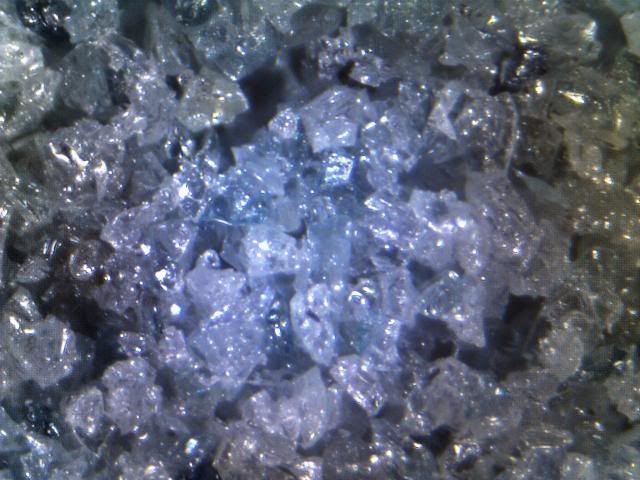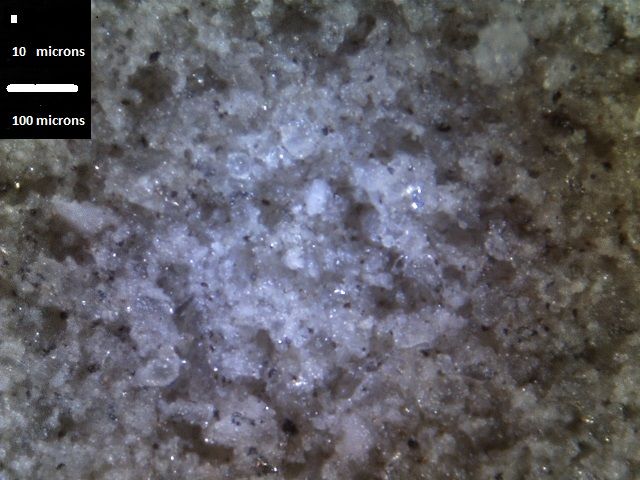
The soft Arkansas is a natural sharpening stone which is in strong contrast to man made stones. The Arkansas stone is simply a solid chuck of Novavulite (basically a type of rock) in contrast to man made stones which are composed of both manufactured abrasives, a bonding media and filler.
Novaculite is a sedimentary rock composed of microcrystalline quartz, it is also recognized as a re-crystallized variety of chert. It is a high-purity silica, composed of more than 99 percent pure silica. The name is applied mainly to formations in Arkansas, Oklahoma, and Texas and is derived from the Latin word novacula, meaning razor stone.


One of the most contested points about these stones is rating them by some kind of grit description. For man made stones it is pretty straight forward. A SPS-II 240X stone for example has an average particle size of 80 microns and thus the 240 grit or 80 micron label is well representative of the basic size of the individual abrasive grits which are spaced apart and act as individual cutting points. However a natural stone like the Arkansas isn't as easy to quantify.
Note how clear it is to rate the SPS-II stone even under low magnification, the grit size can just be visually estimated. However the natural stone doesn't have well defined individual grit/abrasives which can be resolved. There is a surface texture which is somewhat porous due to the nature of the material - Novaculite (a form of quartz). The abrasion takes place by a combination of the surface texture and the holes and the edges which make it naturally very slightly porous.
However it is being used as an abrasive and so what can be given is a grit rating which represents how it abrades. One way to estimate this is simply the type of scratch pattern it produces. Given that there is variation among the stones care has to be taken in giving a definite rating however most describe similar levels of coarseness :
Soft Arkansas (Equivalent to JIS 1200)
and it is commonly listed in micron ratings as 15-25 which is in agreement with that JIS rating from BDL. 2
The Arkansas stone has many of the aspects of a high quality stone as boxed :
However as for consistency of grit, natural stones are essentially just rocks and the consistency and purity of the abrasive is in general one of the ways in which they are graded. A quick check of the surface shows a low more variation than a man made stone. However there are lots of sources for natural stones, this is a very basic one and the more expensive ones are prized exactly for the consistency and density of the abrasive.
This is also one of the reasons why when the goal is to produce the highest level of finish (or polish) from a given stone, individuals will often spend a considerable amount of time with a series of abrasives grinding the surface against glass with a fine paste/slurry. With solid abrasives which are very slow wearing this is a way to manipulate the surface finish and produce various scratch patterns. If the stone is lapped with a very coarse abrasive then it will for a time produce scratch patterns which are coarse.



As an interesting point of comparison to examine the finish or polish applied by the soft Arkansas, a 1095 knife (Mora #1280) was polished :
This produced the near mirror finish on the far right. This surface was then lightly abraded with the Soft Arkansas (middle) and then the 1095 blade was repolished and then again lightly abraded with the Suehiro 'Chemical' 320 grit (30 micron) stone. There are quite a few interesting differences in the surface left by the Soft Arkansas vs the Suehiro 'Chemical' .
Looking at the surface of the Soft Arkansas compared to the Suehiro
'Chemical' 320 grit, then the reasons for this scratch pattern difference are
apparent :
The Arkansas tends to produce a very high polish due to the main surface
texture but occasional produce a large and coarse scratch from the edges of
the holes. This irregular finish is one of the main reasons that these stones
are often heavily lapped with a series of fine pastes to improve the
consistency of the finish. However in time they will just wear in use as well
and get progressively finer simply from wear of the abrasives.
This is why
they also have to be periodically recut to keep them cutting as otherwise the
surface will becomes so smooth then they will stop cutting and start
burnishing. Of course if they are desired to be a finishing stone then this
might be a positive result. As well on a stone such as this where there are
two sides, one side can be lapped periodically on a coarse abrasive and the
other side allowed to wear smooth to produce a very fine polish.
Moving beyond the polish produced and examining the finish by
Espirit baisting thread the Soft Arkansas produces a very high push cutting
sharpness, just behind the Spyderco Medium ceramic and higher than a fine DMT.
This is in agreement with the general grit ratings of the stones.
As expected, the high polish that it applies to the edge while producing
very high push cutting sharpness and cutting ability produces a very low edge
retention slicing abrasive materials. As with any stone, it has to be chosen
based on the finish provided. The very fine finish of the Soft Arkansas works
well for :
However for slicing abrasive materials then a more coarse finish can
provide much stronger and long lasting edge retention.
Grinding an edge on a 3Cr13 stainless steel knife to form an apex, the Soft
Arkansas stone was compared to a Naniwa Superstone 400 (40 micron abrasive).
The knife had the apex
cut off and then the edge reground to an apex three times. The average
performance of both stones in regards to the number of passes to form an edge
:
The Soft Arkansas is about three times slower than the Superstone in
agreement with the abrasive/grit ratio. The Naniwa also forms a very fine silt
slurry naturally which acts to prevent any burr from forming. However the same
effect also makes it difficult to set the final finish of the apex and achieve
a high sharpness as the slurry dulls the apex unless edge trailing passes are
used. It is best used as a prep stone for a final micro-bevel for another
stone. The Soft Arkansas is almost the exact opposite.
This was a very easy to grind
steel as it is soft and very low in carbide volume and it still too over five
hundred passes to set the edge even though it had no damage and was just
lightly dulled. It is obvious then the Soft Arkansas
is not going to be efficient for
significant grinding and is only efficient for micro-beveling as it is
very fine and cuts fairly slowly.
However the nice thing about the Soft Arkansas is that it is a very hard
stone and it doesn't naturally generate a slurry.
This may be a bit misleading given the name as "soft" arkansas but that
is only in comparison to the other grades of Arkansas stones, all of which are
very hard compared to other sharpening stones.
In contrast, the Naniwa Aotoshi 2000, a well regarded waterstone which
produces a similar finish can be cut into with a knife readily.
Note the
pieces cut out of the surface of the stone in the image on the right. This was
achieved with just a force of 250 grams. When using such soft stones care has
to be taken to keep the apex from digging into the surface. However it is
impossible to cut into the Arkansas stone even with much higher force applied
so it is much better to use to apply micro-bevels.
The Soft Arkansas is generally regarded as an oil stone and while it can be
used with water, or even used dry, it will load fairly readily in such
conditions. There are often complaints about oil in regards to mess, however
it has to be understood that stone doesn't need to be soaked, just a light
film of oil applied to the surface and a very neutral oil like light mineral
oil can be used.
The reason the oil is necessary for optimal cutting is that it reduces
friction. High friction surfaces cause a loss of grinding energy by producing
heat. It is a common misconception that oil stops cutting, however it should
be obvious that friction isn't required for cutting. Is an axe "roughed" up
for example to allow it to cut better or is it given a high polish and kept
clean and lubricated.
Arkansas stone are
often promoted as being fairly soft, a common statistic is
820 HK which should not be able to cut very hard and high carbide and HSS
steels. However it was readily able to cut the k390 64 HRC custom blade from
Ozark Traditional Knifeworks. As noted in the images it readily put a
microbevel on top of an edge polished with a 2000 grit Naniwa and the
sharpness increased significantly as measured by push cutting Espirit thread :
Now to be clear, the Naniwa was just used to grind the edge not actual set
the apex so the sharpness was not expected to be high. This was intentional to
provide a contrast for the Soft Arkansas. The edge off the Soft Arkansas
readily :
How to explain it :
The value given for quartz is 1181 kg/mm2, but it is larger on the m prism
faces (1260 kg/mm2) than on the basal plane c (1103 kg/mm2), an obvious
anisotropy.
This is the Vickers hardness which is approximately equivalent to > 70
HRC 1 . Why do so many people claim these stones
can not cut hard and high carbide steels? There are two likely reasons :
As these stones are just solid chunks of abrasive there is no binder so the
abrasive gradually gets very worn, the surfaces get rounded and abrasion and
cutting stops and rubbing starts. The simplest way to condition them is to
lightly rub them on sligly more coarse silicon carbide sandpaper or coarse
grit periodically. As they don't develop a hollow like soft stones, it only
requires a few seconds of work.
Soft Arkansas : Gesswein
Comments can be emailed to Please Use the Forum or by posting to the following thread :
and/or the YouTube Playlist for Abrasives/Sharpening.
Most of the pictures in the above are in the PhotoBucket album.
1
: Hardness Conversion
2
: Sharpening stone grit chart


Cutting Speed and Pressure
Cutting fluids/lubricants
Steel suitability
Summary
Comments and references
Up
Last updated :
Originally written: 31/03/2015